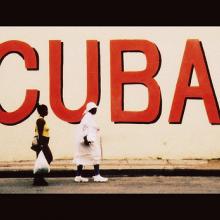cuban churches
IN MARCH, I visited Cuba on a 10-day tour with alumni from Eastern Mennonite University. I’ve studied the socialist structure of the early Jerusalem church (as recounted in Acts 2-6), and I wanted to experience Cuban socialism directly and see how it compares. How, for example, have Christian churches fared under a one-party socialist government?
On our visit, we heard about Cuba’s successes in the areas of health care and education. We heard a lecture on the massive effort to bring Cuba’s average level of education from third grade in 1959 to the current 11th grade. We learned about Cuba’s universal free health care, and that local clinics throughout the island provide basic care accessible to every citizen. As a result, infant mortality is lower than in the U.S. and overall life expectancy is about the same, according to The Atlantic—even though the U.S. spends more than 10 times as much per person per year on health care.
Such basic needs have been met not by Christian churches but by a government that initially robbed the wealthy and shared it with the poor. What were Christians in Cuba—Catholics, Protestants, Anabaptists, and Jehovah’s Witnesses—to make of this enormous shift toward economic equality? After the revolution, most missionaries returned to their home countries, and thousands of Cubans, Christians and otherwise, fled to the United States. Christians who remained had to rethink their mission in a society where the poor were educated and healed through structural change rather than individual charity.
The cars in Cuba fascinate me. Where else in the world can one see a classic 1956 Oldsmobile, a shiny 1957 Chevy, and a 1970 VW bug alongside a new Audi and modern Chinese tour buses?
Our guide said there are four generations of cars in Cuba. First are those pre-revolutionary American cars—the vintage Chevys, Fords, Oldsmobiles, and Studebakers from the 1950s that somehow keep running. Then came the Russian-made Ladas, the small, ugly, square compacts that look like Fiats stripped of any Italian design.
By the ’70s and ’80s, Japanese and other Asian cars started trickling into Cuba, and they became the auto of choice after the fall of the Berlin Wall. Then, in the last decade, the more expensive European cars began showing up. More recently, a fleet of fancy buses, mostly from China, has arrived to shuttle around the 2.5 million tourists now visiting the island each year (and improve public transportation in general).
The cars, of course, reflect the stages of Cuba’s economic relationship with the outside world: the embargo from the U.S., its initial reliance on all things Russian, then growing global trade, followed by the influx of European tourists, and the recent economic resurgence of China.
Cars can now be bought and sold by Cubans. This is one example of dramatic new economic policies, approved last April, being instituted in Cuba. Dr. Osvaldo Martinez, director of Cuba’s World Economy Research Center, called these changes “shock therapy,” like that being experienced by Greece, Spain, and many countries. Cubans should no longer “idolize” the Cuban economic model, Martinez said. Salaries have been increasing faster than productivity. Foods are being imported that could be produced domestically, but weren’t because of the inefficiencies of centralized, Soviet-style agriculture. There has been an “exaggerated number of state employees,” and massive layoffs have been occurring. At times Martinez nearly sounded like a Republican.

Cuba, Dec. 8, 2008. Image via Wylio: http://bit.ly/tQNsK3
Earlier this month, Sojourners board member and former General Secretary of the Reformed Church in America, Wes Granberg-Michaelson, journeyed to Cuba with a delegation of religious leaders from the National Council of Churches.
Their visit culminated in a joint declaration celebrating signs of unity between the U.S. and Cuban churches. Sixteen representatives of U.S. National Council of Churches member communions were in Cuba November 28 through December 2 meeting with Cuban church and political leaders, including President Raúl Castro.
The delegation, which Cuban church leaders said was the highest ranking U.S. church group to visit the island in their memory, was led by the Rev. Dr. Michael Kinnamon, NCC general secretary. The joint statement by the churches declared that normalization of relations between the U.S. and Cuba would be in the best interest of both nations, and the leaders called for the resolution of three humanitarian issues “which cause unjustifiable human misunderstanding and suffering.” Foremost among the issues is the 53-year-old U.S. economic embargo of Cuba that dates back to the administration of President John F. Kennedy.
Read a series of dispatches from Granberg-Michaelson inside God's Politics.
